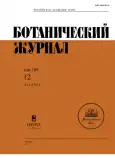Trichophorum cespitosum (Cyperaceae) and its communities in the mires of the Leningrad Region
- Authors: Smagin V.A.1
-
Affiliations:
- V. L. Komarov Botanical Institute of the Russian Academy of Sciences
- Issue: Vol 109, No 12 (2024)
- Pages: 1198-1214
- Section: COMMUNICATIONS
- URL: https://rjsvd.com/0006-8136/article/view/681437
- DOI: https://doi.org/10.31857/S0006813624120026
- EDN: https://elibrary.ru/NOHUGF
- ID: 681437
Cite item
Abstract
Based on the materials of the mires expeditionary team of the BIN RAS, an overview of the plant communities of Trichophorum cespitosum found in the mires of the Leningrad Region is given. Their distribution over the region is shown, as well as their regional specificity which is manifested in various habitats occupied by the communities, and variation of the species dominating in the moss layer in the west-east trend. The classification of Trichophorum cespitosum communities by methods of Russian and European-floristic schools has been carried out. Trichophorum cespitosum grows on various forms of microrelief: ridges, carpets, and hollows. Accordingly, it dominates or represents a part of various plant communities. In terms of floristic syntaxonomy, its communities are included in two classes, Oxycocco-Sphagnetea and Scheuchzerio-Caricetea nigrae. In communities of the first class, the participation of Trichophorum cespitosum is insignificant and is not specified in the names of associations. The species has its ecological optimum in the conditions of moss hollows and carpets, in communities of the order Scheuchzerietalia palustris belonging to the association Eriophoro–Trichophoretum cespitosi. In the studied region, the communities of Trichophorum cespitosum are located on the eastern and southern borders of their distribution range, and belong to different subassociations, some of which are common in the mires of Scandinavia, some in the mires of the northern half of European Russia. Communities with Trichophorum cespitosum are found in the region mainly in oligotrophic bogs, rarely they are described in mesotrophic fens.
Full Text
About the authors
V. A. Smagin
V. L. Komarov Botanical Institute of the Russian Academy of Sciences
Author for correspondence.
Email: smagin.mire@gmail.com
Russian Federation, 2, Professor Popov St., Saint Petersburg, 197022
References
- Balyavichene Yu. 1991. Sintaksonomo-fitogeograficheskaya struktura rastitelnosti Litvy [Syntaxonomy-phytogeographical structure of Lithuanian vegetation]. Vilnyus. 218 p. (In Russ.).
- Blagoveshenskij G.A. 1936. Evolyuciya rastitelnogo pokrova bolotnogo massiva “1007 km” u st. Louhi (Kareliya) [Evolution of the vegetation cover of the bog massif “1007 km” near Lowkhi station (Karelia)]. – Geobotanika. 3: 141–232 (In Russ.).
- Bogdanovskaya-Gienef, 1928 Rastitelnyy pokrov verhovykh bolot russkoy Pribaltiki [Vegetation cover of upland bogs in the Russian Baltics]. – Tr. Petergofskogo estestvenno-nauchnogo in-ta. 5: 265–377 (In Russ.).
- Boch M.S., Smagin V.A. 1987. Redkie associatsii bolot Severo-Zapada evropeyskoy chasti SSSR [Rare associations of mires of the North-West of the European part of the USSR]. – Byull. MOIP. 92(1): 106–114 (In Russ.).
- Boch M.S. 1990. Aapa-mires near Leningrad at the southern limit of their distribution. – Ann. Bot. Fenn. 27(3): 281–286.
- Galkina E.A. 1936. Tipy bolot Tungudskogo rayona Avtonomnoy Karelskoy SSR [Types of mires of the Tungudsky district of the Autonomous Karelian SSR]. – Geobotanika. 3: 307–343 (In Russ.).
- Eurola S. 1962. Über die regionale Einteilung der südfinnischen Moore. – Ann. Bot. Soc. “Vanamo”. 33(2): 1–243.
- Hassel K., Kyrkjeeide M.O., Yousefi N., Prestø T., Stenøien H.K., Shaw J.A., Flatberg K.I. 2018. Sphagnum divinum (sp. nov.) and S. medium Limpr. and their relationship to S. magellanicum Brid. – Journal of Bryology. 40(3): 197–222.
- Ignatov M.S., Afonina O.M., Ignatova E.A. et al. 2006. Checklist of mosses of East Europe and North Asia. – Arctoa. 15: 1–130.
- IPNI: The International Plant Name Index. 2024 (Accessed 23.08.2024).
- Krasnaya kniga Leningradskoy oblasti: Obekty rastitelnogo mira [Red Book of the Leningrad Region: Vegetation Objects]. 2018. St. Petersburg. 848 p. (In Russ.).
- Kuznetsov O.L. 2006. Struktura i dinamika rastitelnogo pokrova bolotnykh ekosistem Karelii [Structure and dynamics of vegetation cover of mires ecosystems of Karelia]. Dis …. Dokt. biol. nauk. Petrozavodsk. 321 p. (In Russ.).
- Masing V. 1958. Rabataimkatte klassifitseerimise printsiibid ja uhikud. – Botaanika-Alased tood. 64: 63–101.
- Mazing V.V. 1964. Rastitelnost verhovyh bolot o-va Saaremaa [Vegetation of bogs on Saaremaa Island]. – Izuchenie rastitelnosti o-va Saaremaa. Tartu. P. 255–276 (In Russ.).
- Masing V. 1982. The plant cover of Estonian bogs: a structural analysis – Peatland ecosystems. P. 50–93.
- Masing V., Aaviksoo K., Kadarik H. 1997. Aerial views and close-up pictures of 30 Estonian mires. Tallinn. 96 p.
- Napreenko M.G. 2002. Flora i rastitelnost verhovykh bolot Kaliningradskoy oblasti [Flora and vegetation of bogs of the Kaliningrad region]. Dis. … Kand. biol. nauk. Kaliningrad. 291 p. (In Russ.).
- Osvald H. Die Vegetation des Hochmoores Komosse – Sv. Vaxtsociol. Sallsk. Uppsala. 1923. Handl. I. 436 S.
- Polevaya geobotanika [Field geobotany]. 1964. T. 3. Moscow; Leningrad. 530 p. (In Russ.).
- Ruuhijärvi R. 1960. Über die regionale Einteilung der nordfinnischen Moore. Helsinki. 360 S.
- Sjörs H. 1948. Myrvegetation I Bergslagen. Uppsala. 299 S.
- Smagin V.A. 1999. [Vegetation of hollows, erseys and wet carpets of bogs of the European North of Russia]. – Bot. Zhurn. 84(1): 104–116 (In Russ.).
- Smagin V.A., Napreenko M.G. 2003 [Communities with Sphagnum rubellum Wils. in bogs of the south-eastern part of the Baltic region]. – Rastitelnost Rossii. 5: 50–61 (In Russ.).
- Sokolova L.A. 1936. Rastitelnost rayona Louhi-Kestengskogo trakta (Kareliya) [Vegetation of the Lowkhi-Kestengsky Tract area (Karelia)]. – Geobotanika. 3: 241–306 (In Russ.).
- Tabaks L.V. 1955. Materialy k issledovaniyu rastitelnogo pokrova oligotrofnykh bolot Primorskoy nizmennosti Latviyskoy SSR [Materials to study the vegetation cover of bogs in the Primorsky lowlands of the Latvian SSR]. – Rastitelnost Latviyskoy SSR. I: 233–258 (In Russ.).
Supplementary files










